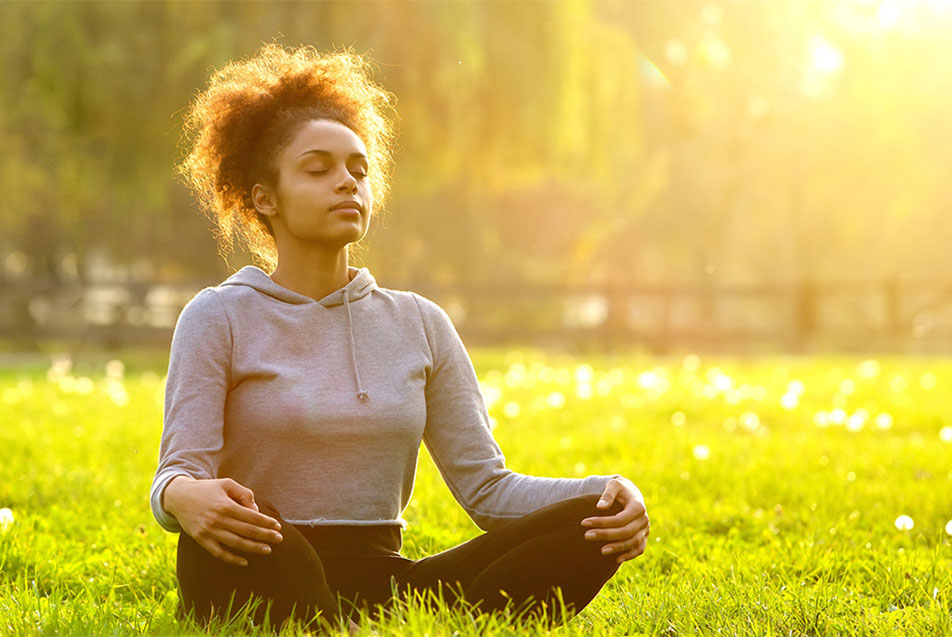Have you ever felt curious about meditating? Maybe it’s time to slow down, block out all the noise, and practice a little mindfulness.
The benefits of meditation are many, and they’re available to everyone — not just Buddhist monks and new-age gurus. In fact, meditation isn’t even about religion. It’s about switching from a state of evaluation (e.g., “Am I doing this right?”) to experience (e.g., feeling your breath), as well as learning to be quietly present in the moment.
When you calm your mind, your body and brain benefit. Studies have shown that regular meditation can lead to:
- Reduced stress — Meditation has been linked to lower levels of the stress hormone cortisol, as well as decreased density in the amygdala, a portion of the brain that grows denser with stress.
- Better memory and focus — People who meditated 30 minutes a day for 8 weeks formed more gray matter in their hippocampus, the part of the brain controlling memory and learning.
- Increased creativity — Research found increases in gray matter density in the area of the brain associated with creativity following mindfulness training.
- Lower blood pressure — Two-thirds of patients in a meditation-based relaxation program were able to lower their blood pressure and reduce medications. Why? Relaxation forms nitric oxide, which opens up blood vessels.
- Reduced pain intensity — A 2013 study found that meditation could reduce pain intensity by 40% and pain unpleasantness by 57%.
- Reduced risk of heart attack and stroke — A mindfulness-based stress reduction study of older adults showed reduced concentrations of C-reactive protein, a marker associated with the development of heart disease.
- Better sleep — One study found that higher levels of mindfulness were linked to lower activation levels at bedtime, which led to better quality sleep.
With benefits like these, it’s no wonder the practice of meditation has lasted thousands of years. The only question now is, how will it help you?
How to meditate in 3 simple steps.
Maybe the reason you haven’t been meditating all these years is because no one ever taught you how. The basics are fairly simple:
- Find a quiet space. The goal here is to create a calm environment that’s free from noises and interruptions. Turn off the TV, close any windows to street sounds, and (if possible) separate yourself from pets and children.
- Sit comfortably. There’s no need for pretzel-like contortions. Just sit comfortably on the floor or in a chair. If you opt for the floor, you might want to use a pillow or cushion so you don’t get sore. If you prefer a chair, try not to lean against the chair-back and don’t slouch. Sit upright while maintaining a relaxed, open posture.
- Focus on your breathing. Close your eyes and observe your breathing, without trying to direct it. Just pay attention to its natural ebb and flow. Experience it with your senses. When your mind starts to wander (and it will), simply acknowledge the stray thought, let it go, and return to the breath. It’s your connection to the present moment.
That, in a nutshell, is meditation. Give it a try! But don’t be discouraged if you have trouble turning off the inner chatter at first. That’s perfectly normal. In fact, many practitioners believe the point of meditation is not to keep your mind from straying, but to repeatedly bring it back to the present. This continual returning to the present moment is where all the good things happen!
A timely tip: To help you focus, set a timer so you’re not constantly checking the time. There may be a built-in timer on your phone, or download a free timer app like SnapTimer or Elapsed. Start with short 2- to 5-minute sessions and work your way up. When the timer goes off, slowly open your eyes and go about your day.
More tips on mindfulness.
In the beginning, as you’re learning to meditate, you might find yourself feeling anxious, bored, frustrated, or even angry. Not exactly the calm, enlightened state you were hoping for? Don’t worry. Feelings like these are completely natural. Remember, your job is not to judge yourself or wonder if you’re “doing it right.” You’re simply an impartial observer. Acknowledge any thoughts or feelings that come up and then let them go. Be okay with whatever happens.
To help you on your path to mindfulness, here are a few more pointers:
- Wear comfortable clothing. Since you don’t want to be distracted while you’re meditating, avoid restrictive clothes like jeans, tight pants or anything that’s too stiff. Loose, breathable attire is best.
- Set the mood. To enhance your meditation experience, you may want to turn on quiet music (no words obviously), light a scented candle or incense, and/or dim the lights.
- Remove all distractions. If you’re hungry, eat a snack first. Go to the bathroom. Silence your cell phone. Make sure the room’s not too hot or too cold. Eliminate every possible distraction before you ever sit down.
- Meditate when you’re already relaxed. Eventually, you’ll be able to use meditation to calm yourself when you’re feeling stressed. But in the beginning, you may find it easier to meditate when you’re already relaxed, such as first thing in the morning or before bed.
- Find your path. There’s no one right way to practice meditation. Besides sitting, you can also lie down or do a walking meditation. You can count your breaths, chant a mantra (think “om”), watch the flicker of a candle flame, or listen to a guided meditation. The important thing is to find a practice that works for you.
- Read up. If you’re serious about meditation, you might want to check out Jon Kabat-Zinn’s landmark book on the subject, Wherever You Go There You Are: Mindfulness Meditation in Everyday Life.
Mindfulness exercise: You can practice mindfulness in other ways, too. Try a walking meditation, or instead of always checking your email, take a break from work by looking out the window. Spend a minute just gazing at the clouds. Watch them do what clouds do, and give your brain a rest from all that thinking. Don’t have a window? Close your eyes instead and listen to the sounds around you, letting them come and go without judgment.




